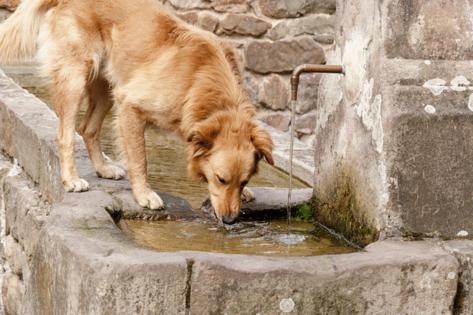Ripples in the water: Chlorination and cancer risk in dogs
Published in Cats & Dogs News
Bladder cancer affects tens of thousands of dogs in the United States each year, with certain breeds like the Scottish Terrier, West Highland White Terrier and Shetland Sheepdog being particularly susceptible.
This suggests a genetic influence on cancer risk, but environmental factors also play a large role in triggering this type of cancer. We already know that human bladder cancer is linked to environmental chemical exposure. People exposed to herbicides, cigarette smoke, inorganic arsenic in groundwater, chlorination byproducts in tap water, and acrolein (a chemical found in indoor air pollution and some heat-treated foods) have a higher risk of developing bladder cancer. Since dogs share our homes and water sources, do they also share this increased cancer risk?
Thanks to funding from the AKC Canine Health Foundation, a nonprofit organization dedicated to advancing the health of all dogs, scientists at the University of Wisconsin-Madison College of Veterinary Medicine have been exploring the link between environmental chemical exposure and cancer in dogs to provide veterinarians and dog owners with proven and practical cancer prevention strategies.
Zeroing in on bladder cancer, they examined exposure to and urinary concentrations of four cancer-causing chemicals: chlorination byproducts, inorganic arsenic, acrolein, and the herbicide 2,4-D. While they found no differences in exposure to arsenic, acrolein, or the herbicide, they did find significant differences in chlorination byproduct exposure between healthy and affected dogs.
Chlorinated water contains breakdown products that can cause genetic mutation. We know there is a link between bladder cancer in people and chlorination byproduct exposure through swimming, bathing, and showering. Similarly, in this study, dogs with bladder cancer were more likely to swim in a chlorinated pool than healthy dogs. In addition, the concentration of chlorination byproducts reported in municipal tap water was four times higher in the zip codes where dogs with bladder cancer lived compared to those where healthy dogs lived.
All of this evidence supports the idea that chlorination byproduct exposure may contribute to the risk of developing bladder cancer in dogs. Therefore, owners of high-risk dog breeds should minimize their dog’s exposure by limiting access to swimming pools and installing water filtration units to remove chlorination byproducts from the dog’s drinking water.
What about environmental chemical exposure and other dog cancers? The research team is also studying chemical exposures and the risk of lymphoma, a cancer of the immune system, in the Boxer Dog breed. Preliminary results suggest that certain chemicals are associated with an increased risk of lymphoma in this breed.
CHF will share the final results of this important research to provide veterinarians and dog owners with even more information to help prevent and treat canine cancer. Visit akcchf.org/caninecancer for more information on CHF’s commitment to fight canine cancer.
©2024 American Kennel Club. Visit at akc.org. Distributed by Tribune Content Agency, LLC







Comments